- Administrator
- Albums and Singles

Artist: Psychic TV
Title: Themes
Catalogue No: CSR123B
Barcode: 8 2356649872 9
Format: 6 x CD in matt-laminate, spot-varnished box
Genre: Esoteric / Ritual / Industrial / Soundtrack
Shipping: 23rd December
For the first time, all THEMES albums by PSYCHIC TV released together, in a sumptuous, embossed box set. The music itself was designed not only as soundtrack but also for subsequent use by Initiates of The Temple Ov Psychick Youth in their rituals as Functional music intended only to aid in the process of making things happen. It is a practical tool. Thee essential collection of rare, archive and modern PTV ritual / esoteric musick! Each CD is presented in it's own matt laminate, spot-varnished mini-LP sleeve. The box also includes a 28-page booklet of rare photos and essays.
"Themes" was originally released in 1982 as a limited bonus LP with the first 5000 copies of the legendary PSYCHIC TV album "Force The Hand Of Chance". Musicians: Stan Bingo, Peter Christopherson (Coil, Throbbing Gristle, Soisong), Genesis P-Orridge, and David Tibet (Current 93).
Themes: 1. Part I | 2. Part II | 3. Part III | 4. Part IV | 5. Part V | 6. Part VI | 7. Part VII | 8. Part VIII
"Themes 2" was originally released on LP in 1985 by Temple Records and subsequently reissued as an extended CD version by Cold Spring in 1997. Musicians: Genesis P-Orridge, Alex Fergusson, John Gosling (Zos Kia, Coil, Mekon). `Themes 2` is presented here as a 2 CD set, including the full vinyl version - plus the original `Unclean` 12" and it`s two B side tracks that were recorded in the same sessions.
Themes 2: 1. Themes 2 Part One | 2. Themes 2 Part Two | 3. Themes 2 Part Three | 4. Unclean | 5. Mirrors | 6. Unclean Monks
Themes 2 - A Prayer For Derek Jarman: 1. The Loops Of Mystical Union | 2. Elipse Of Flowers | 3. Mylar Breeze (Parts 1 And 2) | 4. Mylar Breeze (Part 3) | 5. Prayer For Derek | 6. Rites Of Reversal
"Themes 3" was originally released on LP in 1986 by Temple Records and is presented here for the first time on CD, completely remastered. Musicians: Genesis P-Orridge, John Gosling (Zos Kia, Coil, Mekon), Mark Sangerman, Monte Cazazza. `Themes 3` is presented here as a 2 CD set, with an unheard version performed in Boston, US by Genesis P-Orridge and John Gosling.
Themes 3: 1. Culture | 2. News | 3. Drama | 4. Nature | 5. Science | 6. Implant | 7. Analgesia | 8. Catalepsy | 9. Reverie | 10. Placebo | 11. Induction
Themes 3 - CD2: 1. Culture | 2. News | 3. Drama | 4. Nature | 5. Science | 6. Implant | 7. Analgesia | 8. Catalepsy | 9. Reverie | 10. Placebo | 11. Induction
"Themes 4" is a brand new Psychic TV album, recorded by the late partner of Genesis P-Orridge, Lady Jaye and Psychic TV. Compiled by Genesis Breyer P-Orridge, Ryan Martin and Bryin Dall. Musicians: Lady Jaye Breyer P-Orridge, Genesis Breyer P-Orridge, Larry Thrasher, Bryin Dall.
Themes 4 Lady Jaye: 1. I'm Making A Mirror | 2. I Like The Holidays! (A Children's Story) | 3. Gobbledegook | 4. Mother Jack (A Children's Story) | 5. Candy Factory | 6. I Love You, I Know | 7. This Is The Final War
Get a free bonus CD 'Live In Basildon' 1986 - only when bought from Cold Spring!
Live In Basildon: 1. Thee Degenerate | 2. She Touched Me | 3. Unclean | 4. Riot In Thee Eye Ov Sky | 5. Southern Comfort | 6. Roman P. | 7. Retinal | 8. Ov Power | 9. Godstar
Read More
- Administrator
- Albums and Singles
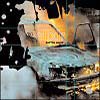 Here is another electronic, beat-based album that plays the game of "Ilove it/I hate it." The atmosphere is mostly dark, the beats thick andchugging, and the melodies somehow buried inside walls of static noiseand time-warped samples. There's the first problem: sometimes themelodies never get a chance to come out and play. As a result, I'm leftlistening to a somewhat boring, somewhat repetitive drum track thatdoesn't have the power to carry the song by itself. Unfortunately, thealbum is produced in such a way that each song inevitably has someincredible sounds on it but they're completely attenuated by the waythey're thrown into the backgroud and lost beneath a plethora ofeffects. But then, amazingly, all that wishy-washy noise comes togetherfor a few brief moments and gives birth to an explosion that comesclose to relieving the tension and weariness of the first few minutesof the song. This is how "Flesh Wound" opens up the album and it seguesinto the infinitely more entertaining "Gargantuan." I imagine one ofthose dolls that has a slinky for a neck bopping around to this rubberyand dynamic wall of beats only to have a stick of dynamite send it intothe great beyond. "Gargantuan" has nearly the same production style as"Flesh Wound," but manages to pull it off by allowing the repeatingdrum and melody patterns to weave a bit more intricate and diverse bodyof sound. "Boiled In Blood" is a bit more low-key than anything else onthe album and it provides a nice break from the havoc of the first twotracks. It unfortunately gives way to more standard four-on-the-floordance music that sounds horribly distorted and only covers up whatseems to be the most interesting elements dying in the background. Andso this process continues throughout the duration of Don't Be Scared.I either love it or I hate it. Not much changes in terms of production:it's all pretty muddy and eventually this makes the entire album feelfar too homogenous. The formula either works for some of the songs orit doesn't. This up and down experience ends up making the whole albumfeel dull; it's just hard to sit down and listen to the whole thing allthe way through.
Here is another electronic, beat-based album that plays the game of "Ilove it/I hate it." The atmosphere is mostly dark, the beats thick andchugging, and the melodies somehow buried inside walls of static noiseand time-warped samples. There's the first problem: sometimes themelodies never get a chance to come out and play. As a result, I'm leftlistening to a somewhat boring, somewhat repetitive drum track thatdoesn't have the power to carry the song by itself. Unfortunately, thealbum is produced in such a way that each song inevitably has someincredible sounds on it but they're completely attenuated by the waythey're thrown into the backgroud and lost beneath a plethora ofeffects. But then, amazingly, all that wishy-washy noise comes togetherfor a few brief moments and gives birth to an explosion that comesclose to relieving the tension and weariness of the first few minutesof the song. This is how "Flesh Wound" opens up the album and it seguesinto the infinitely more entertaining "Gargantuan." I imagine one ofthose dolls that has a slinky for a neck bopping around to this rubberyand dynamic wall of beats only to have a stick of dynamite send it intothe great beyond. "Gargantuan" has nearly the same production style as"Flesh Wound," but manages to pull it off by allowing the repeatingdrum and melody patterns to weave a bit more intricate and diverse bodyof sound. "Boiled In Blood" is a bit more low-key than anything else onthe album and it provides a nice break from the havoc of the first twotracks. It unfortunately gives way to more standard four-on-the-floordance music that sounds horribly distorted and only covers up whatseems to be the most interesting elements dying in the background. Andso this process continues throughout the duration of Don't Be Scared.I either love it or I hate it. Not much changes in terms of production:it's all pretty muddy and eventually this makes the entire album feelfar too homogenous. The formula either works for some of the songs orit doesn't. This up and down experience ends up making the whole albumfeel dull; it's just hard to sit down and listen to the whole thing allthe way through.samples:
Read More
- Administrator
- Albums and Singles
 The air is thick, muggy, and full of nervous chatter. The congregationfinds their seats with the help of ushers dressed in black suits,polite in their assistance and insistence that the growing crowd findtheir seats. The tent is makeshift at best, made from old bed sheetsand a few cracks in the seams are visible to those who look above. Noone is sure what to expect. They've heard the tales of this newminister and his new gospel, but they are apprehensive, perhaps even alittle frightened at the prospect. Then, suddenly, the lights dim, andthe stage explodes with horns, guitar, bass, and heavy percussion. Asthe lights restore the minister sings, no, howlsthe sermon with a boogie that is just shy of satanic, and thecongregation can't help but rise to their feet and join in with theminimal choir that accompanies him. Casey Meehan is that minister, andhis songs aren't the old or new testament, but they are lessons for theweak nonetheless. He sings of being baptised, of being born again, andwith titles like "Who Will Be Saved?" and "Do Right" his mission isclear. He may not be of a formal religion, but he is here to shepherdthe meek through the valley, and he will do so with a bit of Dixie, abit of Storyville, New Orleans, and a lot of moxy and sensual vocalprowess reminiscent of Mark Sandman and Greg Dulli. These songs are thelessons of a man who has been through it all, who sees the masks we allput on and who wants to shatter them, hurling a reality with the forceof a fastball; and like any good evangelist he has sinned as much asthose he tries to save. His band, the Delta Still, are a tight, fierceensemble, and the songs are punishing in places and delicate in others:whatever it takes to get the message out right. The instrumentals aremassive, and through it all Meehan carries the weight with ease, sexingthe microphone for all its worth. For his first record, Meehan isshooting out of the gate, heading down the track at full speed. Catchhim if you can.
The air is thick, muggy, and full of nervous chatter. The congregationfinds their seats with the help of ushers dressed in black suits,polite in their assistance and insistence that the growing crowd findtheir seats. The tent is makeshift at best, made from old bed sheetsand a few cracks in the seams are visible to those who look above. Noone is sure what to expect. They've heard the tales of this newminister and his new gospel, but they are apprehensive, perhaps even alittle frightened at the prospect. Then, suddenly, the lights dim, andthe stage explodes with horns, guitar, bass, and heavy percussion. Asthe lights restore the minister sings, no, howlsthe sermon with a boogie that is just shy of satanic, and thecongregation can't help but rise to their feet and join in with theminimal choir that accompanies him. Casey Meehan is that minister, andhis songs aren't the old or new testament, but they are lessons for theweak nonetheless. He sings of being baptised, of being born again, andwith titles like "Who Will Be Saved?" and "Do Right" his mission isclear. He may not be of a formal religion, but he is here to shepherdthe meek through the valley, and he will do so with a bit of Dixie, abit of Storyville, New Orleans, and a lot of moxy and sensual vocalprowess reminiscent of Mark Sandman and Greg Dulli. These songs are thelessons of a man who has been through it all, who sees the masks we allput on and who wants to shatter them, hurling a reality with the forceof a fastball; and like any good evangelist he has sinned as much asthose he tries to save. His band, the Delta Still, are a tight, fierceensemble, and the songs are punishing in places and delicate in others:whatever it takes to get the message out right. The instrumentals aremassive, and through it all Meehan carries the weight with ease, sexingthe microphone for all its worth. For his first record, Meehan isshooting out of the gate, heading down the track at full speed. Catchhim if you can.samples:
Read More
- Administrator
- Albums and Singles
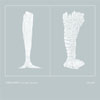 23five came into the public eye as the label vehicle for soundartist-types, peddling the kind of stuff I'd see in the MoMA gift shopand pass by thinking it just wouldn't be the same outside an austeregallery space. Now only 6 releases into stride, the label has proved mewrong several times over. One needs only to hear Furudate &Zbigniew's World As Will II to see why. The opening minutes ofCoelacanth's sophomore release, however, left me with second, or ratherthird, thoughts. The Glass Sponge begins with a sparse scraping,thumping, and clanging that seems on the brink the ever-arty black holeof inaccessibility. After a few minutes, droning bell tones andtempered feedback ease their way in, making the piece more substantialbefore, as quickly as it began, the music fades into silence. Thoseopening bits were merely a prelude to the real meat of track, a sort ofsecond act comprised of layered static and an enriched texture oflulling feedback and prolonged bell tones. Stuttering vocal utteringsrise from drone and static layers that sound truly oceanic. Song titleslike "The Leaden Sea" and "The Violet Shell and Its Raft" lend a marinetheme to The Glass Sponge that feels apt in relation to the music. (Thename Coelacanth, also, refers to a prehistoric fish recently discoveredto still exist). All four tracks exhibit an approach to drone musicthat is both texturally rich and emotionally resonant. Tracks rangefrom gentle, inviting trips across static that gurgles and glimmerslike actual liquid to eerie passages where hollow drones and squealingfeedback rise from the depths. The Glass Sponge is host to a multitudeof bizarre, untraceable sounds as well. Various throbbings, tinkerings,and knockings find comfortable home in Coelacanth's sound world, givenoverture in the album's first moments, making it increasingly hard tobelieve that any of this was gathered from public performance as thenotes describe. This is beautiful, thoroughly engaging, and uniquemusic, no doubt more appropriate headphone music for pretending yourbed is a liferaft than for strolling the museum floor.
23five came into the public eye as the label vehicle for soundartist-types, peddling the kind of stuff I'd see in the MoMA gift shopand pass by thinking it just wouldn't be the same outside an austeregallery space. Now only 6 releases into stride, the label has proved mewrong several times over. One needs only to hear Furudate &Zbigniew's World As Will II to see why. The opening minutes ofCoelacanth's sophomore release, however, left me with second, or ratherthird, thoughts. The Glass Sponge begins with a sparse scraping,thumping, and clanging that seems on the brink the ever-arty black holeof inaccessibility. After a few minutes, droning bell tones andtempered feedback ease their way in, making the piece more substantialbefore, as quickly as it began, the music fades into silence. Thoseopening bits were merely a prelude to the real meat of track, a sort ofsecond act comprised of layered static and an enriched texture oflulling feedback and prolonged bell tones. Stuttering vocal utteringsrise from drone and static layers that sound truly oceanic. Song titleslike "The Leaden Sea" and "The Violet Shell and Its Raft" lend a marinetheme to The Glass Sponge that feels apt in relation to the music. (Thename Coelacanth, also, refers to a prehistoric fish recently discoveredto still exist). All four tracks exhibit an approach to drone musicthat is both texturally rich and emotionally resonant. Tracks rangefrom gentle, inviting trips across static that gurgles and glimmerslike actual liquid to eerie passages where hollow drones and squealingfeedback rise from the depths. The Glass Sponge is host to a multitudeof bizarre, untraceable sounds as well. Various throbbings, tinkerings,and knockings find comfortable home in Coelacanth's sound world, givenoverture in the album's first moments, making it increasingly hard tobelieve that any of this was gathered from public performance as thenotes describe. This is beautiful, thoroughly engaging, and uniquemusic, no doubt more appropriate headphone music for pretending yourbed is a liferaft than for strolling the museum floor. samples:
Read More
- Administrator
- Albums and Singles
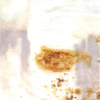 Jim Haynes is a San Francisco-based musician who has made a name for himself through work in the duo Coelacanth and in his travels as a solo sound-artist. The rich SF scene has no doubt provided Haynes with many opportunities to expand his listener-ship, and recently he has ventured eastward with an installation called Magnetic North appearing in Nashville and San Jose. This disc, the first release from The Helen Scarsdale Agency and limited to 300 copies, contains the audio portion of the installation, culled from performances of the last two years. The most striking quality of the music herein can inadequately be described as its organic nature.
Jim Haynes is a San Francisco-based musician who has made a name for himself through work in the duo Coelacanth and in his travels as a solo sound-artist. The rich SF scene has no doubt provided Haynes with many opportunities to expand his listener-ship, and recently he has ventured eastward with an installation called Magnetic North appearing in Nashville and San Jose. This disc, the first release from The Helen Scarsdale Agency and limited to 300 copies, contains the audio portion of the installation, culled from performances of the last two years. The most striking quality of the music herein can inadequately be described as its organic nature.
Haynes has produced four lengthy tracks, each composed entirely of beautiful drones, but drones with a distinctly homespun feel. Contained bell tones and gentle, metallic overtones leak into otherwise hollow, spacious drones that recall the oceanic spaces of Coelacanth's music. At times the listener feels outside, or underground, in a large breathing space, or in the same land that produced Walter Marchetti's cavernous recordings. Haynes has a way, however, of bringing his listener back to reality, back to the tool shed so to speak, as he introduces subtle incidental sounds into the mix. Evocative, even representative of everyday things that clatter, scrape, and squeak, the sound sources remain obscured, the sounds themselves never harsh or even disorienting. Not having seen the Magnetic North installation, I can only guess that it deals with issues of space and the unique transparencies between large and small environments. Haynes' music is accessible in a way that suggests his installation provides a womb-like atmosphere, comfortably merged with wider, harrowing spaces in an examination of the consistencies between the two. His music has neither the stoicism of Marchetti nor the bombast of drone guru Phil Niblock, but feels just right for Haynes' purposes. Though his work with Coelacanth may see him drifting to the outer limits, here Haynes keeps the windswept barrens just outside the door.
samples:
Read More
- Administrator
- Albums and Singles
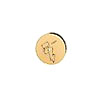 DFA's newest release is a split 12" single. The Juan Maclean's track isa seamlessly realized disco-house anthem that sounds every bit as goodas one of the circa-1980 Larry Levan and Arthur Russell classic Paradise Garagebangers. "Give Me Every Little Thing" is perfect music for a crowdedBrooklyn nighspot on a hot summer night, with its sophisticateddowntown grooves and an r&b-inflected chorus. The Rapture's side isan energetic slab of raw punk-funk with the typically strained vocaldelivery, this time ring-modulated and covered up with a denseproduction that includes atmospheric keyboard swells and a tickingtime-bomb beat. "1, 2, 3, 4, Kick that fucker out the door!" screamsJenner, as the song kicks into electro-house gear. This track is takenfrom The Rapture's forthcoming full-length LP Echoes, and theirsound is gradually becoming more unique and tough to pin down; aconfoundingly addictive combination of post-punk, goth, disco and funkelements.
DFA's newest release is a split 12" single. The Juan Maclean's track isa seamlessly realized disco-house anthem that sounds every bit as goodas one of the circa-1980 Larry Levan and Arthur Russell classic Paradise Garagebangers. "Give Me Every Little Thing" is perfect music for a crowdedBrooklyn nighspot on a hot summer night, with its sophisticateddowntown grooves and an r&b-inflected chorus. The Rapture's side isan energetic slab of raw punk-funk with the typically strained vocaldelivery, this time ring-modulated and covered up with a denseproduction that includes atmospheric keyboard swells and a tickingtime-bomb beat. "1, 2, 3, 4, Kick that fucker out the door!" screamsJenner, as the song kicks into electro-house gear. This track is takenfrom The Rapture's forthcoming full-length LP Echoes, and theirsound is gradually becoming more unique and tough to pin down; aconfoundingly addictive combination of post-punk, goth, disco and funkelements.samples:
- The Juan Maclean - Give Me Every Little Thing
- The Rapture - Killing
Read More
- Administrator
- Albums and Singles
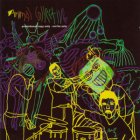 Fat Cat's reissue of the first two Animal Collective releases on one double-disc should not only come as a pleasant surprise to those who discovered the group with this year's excellent Here Comes The Indian, but should also raise the question why it took almost 4 years for the Brooklyn-based project to be courted by a large label. Created by and originally credited to only two Animal Collective members, Spirit They've Gone, Spirit They've Vanished was self-released on Animal Records in 2000.
Fat Cat's reissue of the first two Animal Collective releases on one double-disc should not only come as a pleasant surprise to those who discovered the group with this year's excellent Here Comes The Indian, but should also raise the question why it took almost 4 years for the Brooklyn-based project to be courted by a large label. Created by and originally credited to only two Animal Collective members, Spirit They've Gone, Spirit They've Vanished was self-released on Animal Records in 2000.
The record stands as an entirely cohesive and mature statement from an act with a truly unique sensibility. Avey Tare and Panda Bear, as the duo calls themselves, concoct a potent blend of yesterday-and-today pop, primitive avant-garde-isms and accomplished electronic trickery, with a range of influences almost as surprising as the fact that it all works. The disc begins with "Spirit They've Vanished," an early taste of the extremes to which the Collective travels. The track is organized around a loop of electronic squeal, glitch-laden and slowly modulated as the song progresses. Avey Tare's high, quasi-theatrical singing carves its way through the irregular backing, resulting in something like Bowie singing over a Fennesz track. The second song, "April and the Phantom," introduces the sound that will dominate the majority of Spirit in which the vocals' deceptively simple pop hooks (still sounding Bowie or Barrett) are augmented by viciously strummed acoustic lines, psychedelic synth bits, and tight, sometimes tribal snaring. The song also foregrounds a degree of unpredictability that will continue throughout the disc. Noise bursts frequently interrupt the melody and the seductive vocals often turn to piercing screams; the song's structure is also deceptive with established hooks or rhythms mutating swiftly into rich new song-forms without warning. While listening, I was often pleasantly surprised to find that the same six-minute song was still playing when I was sure two more had already passed.
A thoroughly psychedelic atmosphere exists throughout all Animal Collective music, however bound by a pop sensibility and the healthy abandon of noise-rock's influence. Comparisons could be made to the pastoral skronk of friends Black Dice, though the Collective's palpable pop conviction sets them apart. Spirit's closer, the epic "Alvin Row," provides ample evidence, as all screaming and noisy electronic tweaking is kept to drastic low, leaving gorgeous organ and piano lines to fill the spaces between Tare's vocals, at their best here. Still somewhat in the Bowie/Barrett vein, the singing begins to carve its own niche in these final seven minutes, to assert itself as a voice that is uniquely frightening, endearing, and melancholic, a bit like a forest creature. Sadly, Danse Manatee is not as cohesive or as instantly appealing as its predecessor, though it does show the Collective moving in new directions, later brought to maturity on Here Comes the Indian. Most songs feature a fragmented, increasingly electronic foundation, some sounding more like studio experiments than arranged pieces. Remnants of Spirit's psychedelic pop are present in the blissful "Essplode," and the droning "Ahhh Good Country," but most songs are obscured by experimental leanings that will be better integrated in later efforts. Regardless, this double-disc is a welcome introduction for new fans (if only for Spirit), and is a must-have for anyone indoctrinated by this prolific act's recent output.
samples:
Read More
- Administrator
- Albums and Singles
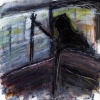 On previous albums, Do Make Say Think played their own blend ofpsych-rock with jazz influence in an effort to explore the stars andplanets, drifting off into their own orbit. Occasionally, as on theirlast album, they got so close to the stars that they brought back somedust here and there, or they gathered sunlight and a planet'satmosphere through which to project their instrumental structures,resulting in a fluid and pleasant listen. For their fourth album,however, they've created a work of true beauty, as though they'velanded on a new planet they can finally call their own. Winter Hymn Country Hymn Secret Hymnis best listened to as a whole, or on vinyl where it is split intothree thematic parts. Overall the album is a step more towardscohesion, with every song blending into the next and creating animmersive feel. Structurally, the parts of the record are separated bytheir slight differences, with the first area covering blending guitarwork, the second infusing more horns for flavor, and the last sectionbleeding into sliced structures with effects and dischordant cacaphony.Ultimately, it all gives way to the hymnal "Hooray! Hooray! Hooray!,"with full organ computer glitch wonder and western guitar with afterschool chorale. It's as though the experience and different sides ofthe band—sometimes warring for control before or finding their way outonly here and there#151;are now one, omniscient and comfortable,allowing for a full, varied, and complex sound that covers a lot ofground and never sounds disjointed. Every song tells a story, turnspage after page, building to a truly bright and vibrant climax thatwhen finally reached makes the whole journey seem all the moreworthwhile. Do Make Say Think are growing into themselves with everyrelease, and their latest shows a comfort and complacence that can onlyserve them well in the future.
On previous albums, Do Make Say Think played their own blend ofpsych-rock with jazz influence in an effort to explore the stars andplanets, drifting off into their own orbit. Occasionally, as on theirlast album, they got so close to the stars that they brought back somedust here and there, or they gathered sunlight and a planet'satmosphere through which to project their instrumental structures,resulting in a fluid and pleasant listen. For their fourth album,however, they've created a work of true beauty, as though they'velanded on a new planet they can finally call their own. Winter Hymn Country Hymn Secret Hymnis best listened to as a whole, or on vinyl where it is split intothree thematic parts. Overall the album is a step more towardscohesion, with every song blending into the next and creating animmersive feel. Structurally, the parts of the record are separated bytheir slight differences, with the first area covering blending guitarwork, the second infusing more horns for flavor, and the last sectionbleeding into sliced structures with effects and dischordant cacaphony.Ultimately, it all gives way to the hymnal "Hooray! Hooray! Hooray!,"with full organ computer glitch wonder and western guitar with afterschool chorale. It's as though the experience and different sides ofthe band—sometimes warring for control before or finding their way outonly here and there#151;are now one, omniscient and comfortable,allowing for a full, varied, and complex sound that covers a lot ofground and never sounds disjointed. Every song tells a story, turnspage after page, building to a truly bright and vibrant climax thatwhen finally reached makes the whole journey seem all the moreworthwhile. Do Make Say Think are growing into themselves with everyrelease, and their latest shows a comfort and complacence that can onlyserve them well in the future.samples:
Read More
- Administrator
- Albums and Singles
The recordings made by Christoph Heeman and Achim Flaam as HirscheNichts Auf Sofa has an appealingly built-in obsolescence. The bulk ofthe original catalog was released in small cassette and vinyl editionson Germany's DOM records, and with the exception of the five LPsrecently re-released in deluxe CD editions, most of the music remainsextremely scarce, making it great fodder for obsessive collectors.Unfortunately, many HNAS-related satellite projects such as MiesesGegonge, Duka Bass Band and Speck Nusseck have remained unreleased andlargely ignored. Recently G. Gonge Produktionen released this series ofCD-Rs, issuing six of the rarest DOM cassettes. Be warned: these discsare unofficial bootlegs, the original recordings have not beendigitally remastered, there are no bonus tracks and the packagingconsists of xeroxes of the original tape sleeves. Despite theselimitations, it's great to be able to hear the music again for thefirst time. Listening to these recordings 20 years after makes menostalgic for a lost age when esoteric and experimental underground DIYcassette labels flourished, not yet having been rendered obsolete bythe digital revolution. Creeping into this world of throwaway musiqueconcrete, off-kilter improvisation and drug-addled musical in-jokes islike rummaging through the dusty attic of a 90-year-old schizophrenicwho obsessively saves everything; it's a series of clues with nosolution, flashes of momentary inspiration and frustratingly stillbornideas. In short, the stuff of life.
MIESES GEGONGE, "LIVE" 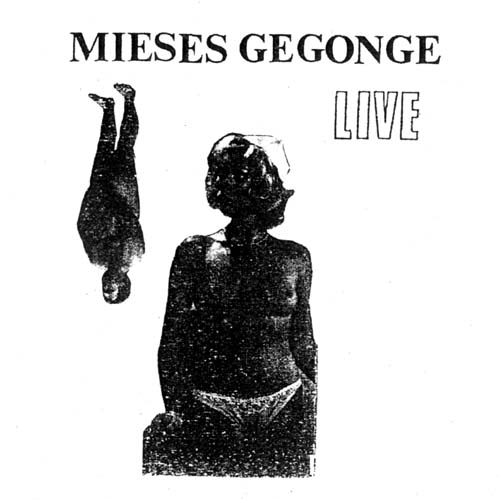 Mieses Gegonge are something of a mystery, but they appear to be asister group to HNAS, having shared the credit for the first HNAS albumAbwassermusik. The material on this CD is culled from two liveperformances in 1985. The sound is very strange indeed: a twistedcombination of arrhythmic percussion together with horribly phased anddistorted vocals. The treated voices and drums are immediatelyreminiscent of the "psych-out" sections of classic Can constructionslike "Halleluwah" and "Aumgn." However, Mieses Gegonge is all psych-outwith no breaks for coherence. Bizarre chants and ululations quaver andripple across layers of randomly beaten skins and gongs, reverbed andwarped into oblivion. If anyone attending these performances wasn't onat least three hits of fine Dusseldorf acid, I feel sorry for them. Therecording is shitty and wracked with distortion, which adds interestingbursts of high-frequency noise that contribute to the lunacy. Imagine apost-lobotomy 23 Skidoo trying to cover The Master Musicians of Jajoukawith nothing but a saw and a zither and William Bennett playing oneroom over, and you might begin to approximate the experience of Live.It's a uniquely fucked sound that will appeal to jaded listenerslooking for a surreal thrill.
Mieses Gegonge are something of a mystery, but they appear to be asister group to HNAS, having shared the credit for the first HNAS albumAbwassermusik. The material on this CD is culled from two liveperformances in 1985. The sound is very strange indeed: a twistedcombination of arrhythmic percussion together with horribly phased anddistorted vocals. The treated voices and drums are immediatelyreminiscent of the "psych-out" sections of classic Can constructionslike "Halleluwah" and "Aumgn." However, Mieses Gegonge is all psych-outwith no breaks for coherence. Bizarre chants and ululations quaver andripple across layers of randomly beaten skins and gongs, reverbed andwarped into oblivion. If anyone attending these performances wasn't onat least three hits of fine Dusseldorf acid, I feel sorry for them. Therecording is shitty and wracked with distortion, which adds interestingbursts of high-frequency noise that contribute to the lunacy. Imagine apost-lobotomy 23 Skidoo trying to cover The Master Musicians of Jajoukawith nothing but a saw and a zither and William Bennett playing oneroom over, and you might begin to approximate the experience of Live.It's a uniquely fucked sound that will appeal to jaded listenerslooking for a surreal thrill.
samples:
DUKA BASS BAND, "FRAULEIN CASANOVA"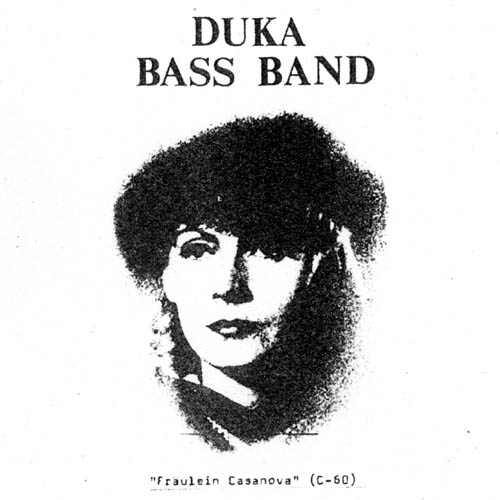 Duka Bass Band appears to be a trio consisting of Lasse Laudrup, Martin B. Klaeren and Sven Nykvist. On Fraulein Casanova,they are joined on a few tracks by Christoph Heeman and Achim P. LiKhan of HNAS, and Heeman also produced the album. The Duka Bass Band'ssound is a fuzzy, primitive clamor of clueless post-jazz improvisationsthat meander aimlessly and appear to fly in several differentdirections at once. It has a certain amateurish quality and a creepysubterranean feel that appeals to me, although I couldn't say exactlywhy. In the exclusively German liner notes, Heeman muses "Fraulein Casanovais for me a jerking step forward into the natural alreadyness ofmusic." Perhaps this dodgy AltaVista translation should not be trusted,but it's as good an explanation as any for the oddly surreal freeplaying on display here. The opening track is the seven-minute"Zauberformeln," which means 'magical formulas.' It's an aptdescription for the mysterious forces that transform the sound ofdeficiently played clarinet, organs and drums into a strange alchemicalgold that is more than the sum of its components. There are momentsthroughout Fraulein Casanova that touch on elements of firemusic improvs, belabored Shaggs-style guitar, and in the case of thelast track (whose title loosely translates to "For God, 1000 Years IsLike a Day"), a ramshackle psych-folk jam not dissimilar from therecent work of Sunburned Hand of the Man. This is my personal favoriteof the six bootlegs, and I look forward to further recordings by thismysterious post-industrial jazz trio materializing at some future point.
Duka Bass Band appears to be a trio consisting of Lasse Laudrup, Martin B. Klaeren and Sven Nykvist. On Fraulein Casanova,they are joined on a few tracks by Christoph Heeman and Achim P. LiKhan of HNAS, and Heeman also produced the album. The Duka Bass Band'ssound is a fuzzy, primitive clamor of clueless post-jazz improvisationsthat meander aimlessly and appear to fly in several differentdirections at once. It has a certain amateurish quality and a creepysubterranean feel that appeals to me, although I couldn't say exactlywhy. In the exclusively German liner notes, Heeman muses "Fraulein Casanovais for me a jerking step forward into the natural alreadyness ofmusic." Perhaps this dodgy AltaVista translation should not be trusted,but it's as good an explanation as any for the oddly surreal freeplaying on display here. The opening track is the seven-minute"Zauberformeln," which means 'magical formulas.' It's an aptdescription for the mysterious forces that transform the sound ofdeficiently played clarinet, organs and drums into a strange alchemicalgold that is more than the sum of its components. There are momentsthroughout Fraulein Casanova that touch on elements of firemusic improvs, belabored Shaggs-style guitar, and in the case of thelast track (whose title loosely translates to "For God, 1000 Years IsLike a Day"), a ramshackle psych-folk jam not dissimilar from therecent work of Sunburned Hand of the Man. This is my personal favoriteof the six bootlegs, and I look forward to further recordings by thismysterious post-industrial jazz trio materializing at some future point.
samples:
SPECK NUSSECK & DIE LEGENDAREN FETTBOYS, "DANCEMUSIC FUR DICKE BACKER"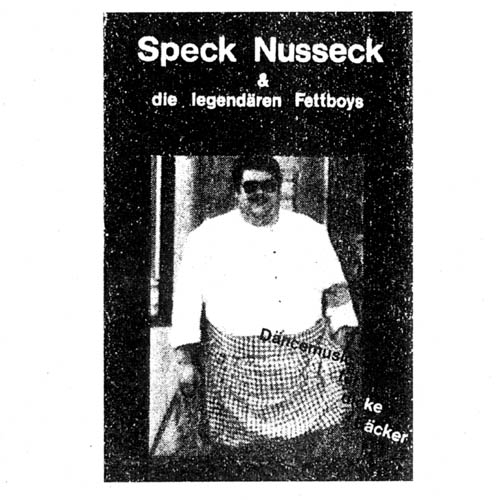 It's anyone's guess who the hell Speck Nusseck or The Legendary FatBoys are, or where they come from, or what masochistic weirdoencouraged them to record Dancemusic Fur Dicke Backer.The answers to these questions are not readily apparent, and they maynever become clear. The only thing we have to go on are the seven songscomprising Dancemusic, for which the word "annoying" seemswoefully inadequate. Plodding drum machine rhythms and randomly pluckedbass compete with vocals shouted into a megaphone backed by lamekeyboard effects which underscore the mess. I'm tempted to call thisoutsider music, but that would suggest that it is charmingly sincereand/or amateurish music that has worthwhile elements. Unfortunately,Speck Nusseck are neither charming nor sincere, and they are not worthanyone's time. They appear to be influenced by the edgy post-punk ofSection 25, the noisy effrontery of Throbbing Gristle and even themotorik beats of Neu!, but they are terribly unequal to the job ofpaying homage to their heroes. The best thing that can be said aboutthis album is that it is mercifully short, and would likely make anexcellent way to get rid of the last few people still hanging out inyour living room after the party is over.
It's anyone's guess who the hell Speck Nusseck or The Legendary FatBoys are, or where they come from, or what masochistic weirdoencouraged them to record Dancemusic Fur Dicke Backer.The answers to these questions are not readily apparent, and they maynever become clear. The only thing we have to go on are the seven songscomprising Dancemusic, for which the word "annoying" seemswoefully inadequate. Plodding drum machine rhythms and randomly pluckedbass compete with vocals shouted into a megaphone backed by lamekeyboard effects which underscore the mess. I'm tempted to call thisoutsider music, but that would suggest that it is charmingly sincereand/or amateurish music that has worthwhile elements. Unfortunately,Speck Nusseck are neither charming nor sincere, and they are not worthanyone's time. They appear to be influenced by the edgy post-punk ofSection 25, the noisy effrontery of Throbbing Gristle and even themotorik beats of Neu!, but they are terribly unequal to the job ofpaying homage to their heroes. The best thing that can be said aboutthis album is that it is mercifully short, and would likely make anexcellent way to get rid of the last few people still hanging out inyour living room after the party is over.
samples:
HNAS, "ICH KANNTE EINEN GUMMIBAUM"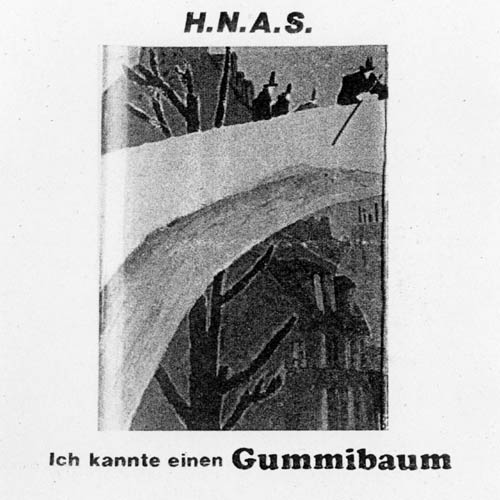 HNAS are invariably compared to Nurse With Wound, and more often thannot to the detriment of Heeman and company. It seems that they areforever doomed, relegated to an obscure footnote in the NWW story bywriters and critics, who seem unable to realize that HNAS use their ownunique strategies to portray their particular brand of audiosurrealism. HNAS does not revel in the exaggerated psychedelicgrotesqueries of Steven Stapleton's work — their tactics are sloppier,less calculated, and in many cases even stranger. The seminal krautrockband Faust is a much more analogous comparison. Heeman and Khan's pathwas paved by Faust's willfully messy LPs that cycled through disparatehalf-formed musical ideas and random piss-takes. Ich Kannte Einen Gummibaumis a good demonstration of their distinct sound. The first trackcreates a creeping quasi-rhythmic industrial atmosphere, recalling theearly work of Laibach, but Heeman's deliberately muddy production andmuffled sounds of voices, distant guitar solos and graveyard organs adda nebulous mystery belonging to HNAS alone. The second track, "Kill DenAchim" is culled from a live performance, and finds the band in agloriously anarchic phase. A woman screams violent provocations backedby oblivious, repetitive electric guitar licks and sheets of live noiseand distortion. On "Ich bin ja besser," a disco record is obscured bylayers of cacophonous whalesong. Track five loosely translates to "AWinter Without Skin Problems," in which a disintegrating chamberorchestra fights against encroaching electronic squalls. The last trackis an extended 25-minute construction combining silly-cum-sinistervocal mutations alongside nonsense percussion. The lunacy segues into alengthy section of concrete tape edits, combining impressionistic pianopieces with field recordings and samples drawn from German televisionand radio.
HNAS are invariably compared to Nurse With Wound, and more often thannot to the detriment of Heeman and company. It seems that they areforever doomed, relegated to an obscure footnote in the NWW story bywriters and critics, who seem unable to realize that HNAS use their ownunique strategies to portray their particular brand of audiosurrealism. HNAS does not revel in the exaggerated psychedelicgrotesqueries of Steven Stapleton's work — their tactics are sloppier,less calculated, and in many cases even stranger. The seminal krautrockband Faust is a much more analogous comparison. Heeman and Khan's pathwas paved by Faust's willfully messy LPs that cycled through disparatehalf-formed musical ideas and random piss-takes. Ich Kannte Einen Gummibaumis a good demonstration of their distinct sound. The first trackcreates a creeping quasi-rhythmic industrial atmosphere, recalling theearly work of Laibach, but Heeman's deliberately muddy production andmuffled sounds of voices, distant guitar solos and graveyard organs adda nebulous mystery belonging to HNAS alone. The second track, "Kill DenAchim" is culled from a live performance, and finds the band in agloriously anarchic phase. A woman screams violent provocations backedby oblivious, repetitive electric guitar licks and sheets of live noiseand distortion. On "Ich bin ja besser," a disco record is obscured bylayers of cacophonous whalesong. Track five loosely translates to "AWinter Without Skin Problems," in which a disintegrating chamberorchestra fights against encroaching electronic squalls. The last trackis an extended 25-minute construction combining silly-cum-sinistervocal mutations alongside nonsense percussion. The lunacy segues into alengthy section of concrete tape edits, combining impressionistic pianopieces with field recordings and samples drawn from German televisionand radio.
samples:
HNAS, "THE UNCOLLECTED ULTRA RARE & UNRELEASED"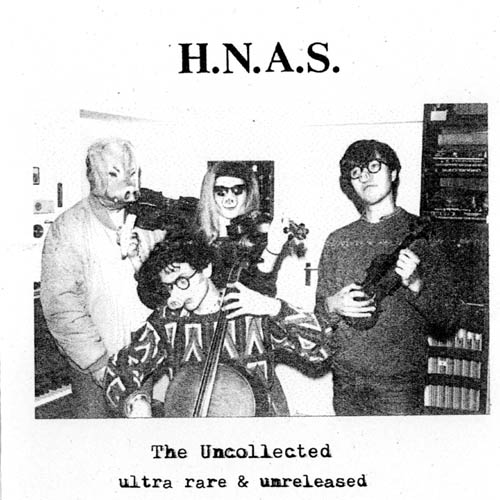 Another in a trilogy of rare HNAS cassette titles issued by G. Gonge, The Uncollectedis an odds-and-sods anthology, collecting tracks from out-of-printcompilations and rare cassettes, as well as some previously unreleasedmaterial. As such it is an uneven and incoherent listen, but with aband as unorthodox as HNAS, that's hardly a problem. Most of the tracksare in the jagged cut-and-splice style recognizable from mid-80's HNASalbums. It feels a bit like an audio version of the absurdist photo andtext collages found in early punk zines. More than once these piecesdigress into the stoned chatter and laughter of a group of youngGermans, who I can only assume to be Christoph, Achim, and friends.Recording and including this unseemly screwing-about on their albumstakes the music out of the realm of the dryly conceptual oravant-garde, and into the "anything goes" realm of DIY homeexperimentalism. That said, there is also much that is musicallyimpressive among these songs, as in the noir queasiness of "DemPetermann zu Ehren," a dark piano dirge. "Was wir von Cassetten halten4" is a phased electronic piece with looped sing-song vocals recallsearly Current 93. "Wie ein Bock am Michekstag" is similar to the workPeople Like Us, juxtaposing dialogue samples from a "Learn to SpeakSwedish" tape with a kitschy exotica loop. The final song is a rare andlovely track by Duka Bass Band: more demented post-jazz with sinisterundertones.
Another in a trilogy of rare HNAS cassette titles issued by G. Gonge, The Uncollectedis an odds-and-sods anthology, collecting tracks from out-of-printcompilations and rare cassettes, as well as some previously unreleasedmaterial. As such it is an uneven and incoherent listen, but with aband as unorthodox as HNAS, that's hardly a problem. Most of the tracksare in the jagged cut-and-splice style recognizable from mid-80's HNASalbums. It feels a bit like an audio version of the absurdist photo andtext collages found in early punk zines. More than once these piecesdigress into the stoned chatter and laughter of a group of youngGermans, who I can only assume to be Christoph, Achim, and friends.Recording and including this unseemly screwing-about on their albumstakes the music out of the realm of the dryly conceptual oravant-garde, and into the "anything goes" realm of DIY homeexperimentalism. That said, there is also much that is musicallyimpressive among these songs, as in the noir queasiness of "DemPetermann zu Ehren," a dark piano dirge. "Was wir von Cassetten halten4" is a phased electronic piece with looped sing-song vocals recallsearly Current 93. "Wie ein Bock am Michekstag" is similar to the workPeople Like Us, juxtaposing dialogue samples from a "Learn to SpeakSwedish" tape with a kitschy exotica loop. The final song is a rare andlovely track by Duka Bass Band: more demented post-jazz with sinisterundertones.
samples:
HNAS, "DIE DREHORGEL ALS FEUERSPRITZE"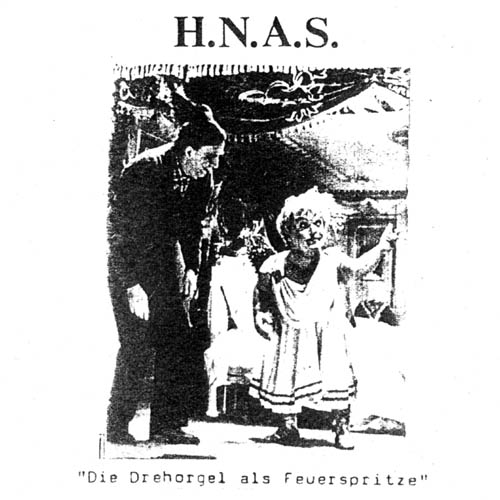 The first track of Die Drehorgel Als Feuerspritzewas recorded live in 1984, the title roughly translating to "TheParadoxes and Secret Sciences of the World." It's one of the bestpieces I've heard HNAS' prolific oevre, a murky sound sculpturecomprising long-form synth drones and gothic organ swells. The sticky,shapeless drones and burbling moogs converge into caverns filled withfloating stone obelisks that chisel strange patterns into thelistener's consciousness. The piece develops using an interior logic, adreamlike coherence that slowly asserts itself over the course of halfan hour. "Barenklammer" was recorded for an as-yet-unreleased HNASvideo, and contains some of the same source material as the firsttrack, quite reminiscent of the synthesizer arpeggiations andavant-rock noise that characterized Tangerine Dream's Electronic Meditationalbum. The third track pushes my PANIC buttons: a manipulative noisepiece that plays like Bernard Herrmann's string tribute to Whitehouse.The layered voices and random bass slaps of the last track evokes Crasscovering a Hildegaard von Bingen chant while tripping on mushrooms.This is a concentrated effort by HNAS, and its single-minded absurditymakes it the most consistent of the three HNAS CD-Rs reissued by G.Gonge. As more of these rare recordings come to light, perhaps HNAS canfinally crawl out of the long shadow cast by Nurse With Wound andreveal themselves to be every bit as unique, talented and vital.
The first track of Die Drehorgel Als Feuerspritzewas recorded live in 1984, the title roughly translating to "TheParadoxes and Secret Sciences of the World." It's one of the bestpieces I've heard HNAS' prolific oevre, a murky sound sculpturecomprising long-form synth drones and gothic organ swells. The sticky,shapeless drones and burbling moogs converge into caverns filled withfloating stone obelisks that chisel strange patterns into thelistener's consciousness. The piece develops using an interior logic, adreamlike coherence that slowly asserts itself over the course of halfan hour. "Barenklammer" was recorded for an as-yet-unreleased HNASvideo, and contains some of the same source material as the firsttrack, quite reminiscent of the synthesizer arpeggiations andavant-rock noise that characterized Tangerine Dream's Electronic Meditationalbum. The third track pushes my PANIC buttons: a manipulative noisepiece that plays like Bernard Herrmann's string tribute to Whitehouse.The layered voices and random bass slaps of the last track evokes Crasscovering a Hildegaard von Bingen chant while tripping on mushrooms.This is a concentrated effort by HNAS, and its single-minded absurditymakes it the most consistent of the three HNAS CD-Rs reissued by G.Gonge. As more of these rare recordings come to light, perhaps HNAS canfinally crawl out of the long shadow cast by Nurse With Wound andreveal themselves to be every bit as unique, talented and vital.
samples:
Read More
- Administrator
- Albums and Singles
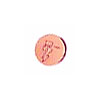 Black Dice is an entirely different proposition from the legions ofretro-disco and post-punk derivatives, and it is tempting to wonderjust what they're doing on a label like DFA. The easy answer is thatthey are excellent, and Murphy and Goldsworthy are able to recognizebrilliance, even when it comes in a package as noisy and uncommercialas Black Dice's Beaches and Canyons."Cone Toaster" is decidedly more rhythmic than much of the material onthat LP, but it still can't qualify as dance music, unless we'retalking about free-PCP night at the Mindfuck Discoteque. Black Dice'sheavy, psychedelic abrasiveness is informed by the krautrock of Can,the tribal Japanoise of The Boredoms and the punk-metal bombast of BigBlack. "Cone Toaster" is a mind-scraping gallery of atonal scrapings,polyrhythms, echo-chambered chanting and gloriously unhinged accidentsof improvisation. The b-side is a remix of the album track "EndlessHappiness" by Yamatsuka Eye (from The Boredoms) which remakes the songinto a hyperspeed hallucinogenic tribal-house track that wouldn't soundout of place of Eye's terrifically odd DJ Pica Pica Pica Planetary Love Gasmix CD. Eye takes the strange tactic of adding a more-or-less danceablebeat, sonically perverting the guitar and basslines into a cacophony ofshimmering protoplasm while adding the usual galaxy of chimes, whistlesand birdcalls that define his singularly whimsical and chaoticpunk-psych. This 12" is one of the most consistently enjoyable plattersof avant-garde lunacy released this year.
Black Dice is an entirely different proposition from the legions ofretro-disco and post-punk derivatives, and it is tempting to wonderjust what they're doing on a label like DFA. The easy answer is thatthey are excellent, and Murphy and Goldsworthy are able to recognizebrilliance, even when it comes in a package as noisy and uncommercialas Black Dice's Beaches and Canyons."Cone Toaster" is decidedly more rhythmic than much of the material onthat LP, but it still can't qualify as dance music, unless we'retalking about free-PCP night at the Mindfuck Discoteque. Black Dice'sheavy, psychedelic abrasiveness is informed by the krautrock of Can,the tribal Japanoise of The Boredoms and the punk-metal bombast of BigBlack. "Cone Toaster" is a mind-scraping gallery of atonal scrapings,polyrhythms, echo-chambered chanting and gloriously unhinged accidentsof improvisation. The b-side is a remix of the album track "EndlessHappiness" by Yamatsuka Eye (from The Boredoms) which remakes the songinto a hyperspeed hallucinogenic tribal-house track that wouldn't soundout of place of Eye's terrifically odd DJ Pica Pica Pica Planetary Love Gasmix CD. Eye takes the strange tactic of adding a more-or-less danceablebeat, sonically perverting the guitar and basslines into a cacophony ofshimmering protoplasm while adding the usual galaxy of chimes, whistlesand birdcalls that define his singularly whimsical and chaoticpunk-psych. This 12" is one of the most consistently enjoyable plattersof avant-garde lunacy released this year.samples:
Read More
- Administrator
- Albums and Singles
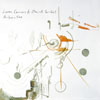 The late morning autumn sky is grey, at least as much of it that can beseen past the tops of the tall buildings. People walk by in slowmotion. A bird hangs in what looks like suspended animation, waiting topounce on the next piece of bread somebody drops or a knish that fallsfrom a moving cart. The collaborative record between Connors and Grubbsisn't a pretty walk in the fields, it's the sound of a dark, urbancityscape. It's also a bit of a juxtaposition. While there's certainlyno rules either collaborator always follow, I'm typically used todissonance from David Grubbs' solo work and soft flowing motions fromLoren (MazzaCane) Connors. The instrumental live in the studiorecording of Arborvitaeopens with soft, flowing piano chord progressions provided by David andharsh guitar tones from Loren. (Additionally, the titles suggest aspringtime theme, but I get a completely different feeling.) As thedaylight comes to an early end, so reflects the mood of the album. Bitby bit, the brightness fades. Half-way through the disc, on "The Ghostof Exquisite," both are playing guitars and feeding off each other'sbleak tonality. By the end of the album, the cold night has fallen."The Highest Point in Brooklyn" features the return of Grubbs on piano,this time, with a much more uneasy, uncomfortable rush, played upagainst the distorted abrasive notes of Connors' guitar, restless anddirty. In fact, at some points, Connors sounds like he doesn't evencare if the instrument cords even come loose from his guitar. The roomsounds, probably picked up by the piano microphone, are those of twopeople getting a little antsy in their chairs. Intentional or not, it'sa subtle hint at a tension, yet by the end of the piece (and thealbum), the calmness has returned. The night has grown as quiet as it'sgoing to get in a city that doesn't sleep.
The late morning autumn sky is grey, at least as much of it that can beseen past the tops of the tall buildings. People walk by in slowmotion. A bird hangs in what looks like suspended animation, waiting topounce on the next piece of bread somebody drops or a knish that fallsfrom a moving cart. The collaborative record between Connors and Grubbsisn't a pretty walk in the fields, it's the sound of a dark, urbancityscape. It's also a bit of a juxtaposition. While there's certainlyno rules either collaborator always follow, I'm typically used todissonance from David Grubbs' solo work and soft flowing motions fromLoren (MazzaCane) Connors. The instrumental live in the studiorecording of Arborvitaeopens with soft, flowing piano chord progressions provided by David andharsh guitar tones from Loren. (Additionally, the titles suggest aspringtime theme, but I get a completely different feeling.) As thedaylight comes to an early end, so reflects the mood of the album. Bitby bit, the brightness fades. Half-way through the disc, on "The Ghostof Exquisite," both are playing guitars and feeding off each other'sbleak tonality. By the end of the album, the cold night has fallen."The Highest Point in Brooklyn" features the return of Grubbs on piano,this time, with a much more uneasy, uncomfortable rush, played upagainst the distorted abrasive notes of Connors' guitar, restless anddirty. In fact, at some points, Connors sounds like he doesn't evencare if the instrument cords even come loose from his guitar. The roomsounds, probably picked up by the piano microphone, are those of twopeople getting a little antsy in their chairs. Intentional or not, it'sa subtle hint at a tension, yet by the end of the piece (and thealbum), the calmness has returned. The night has grown as quiet as it'sgoing to get in a city that doesn't sleep.samples:
Read More